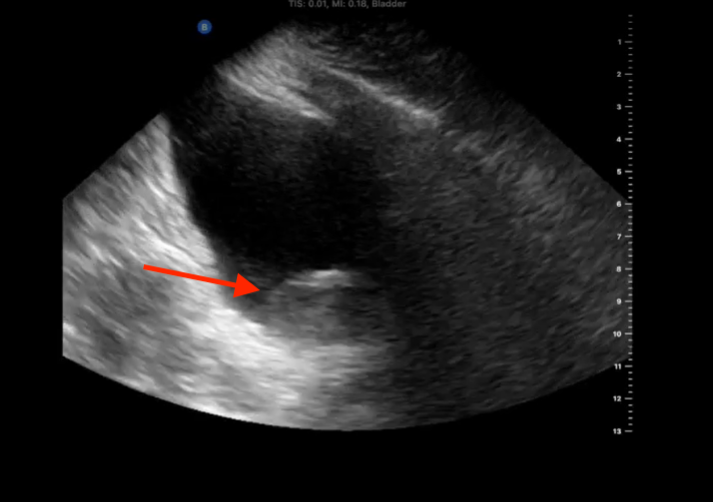CASE PRESENTATION
Urothelial Carcinoma Detected by POCUS in Ambulatory Care Setting
Umair Khalid MD, Abdul Alcozie MD
SAMC Department of Family Medicine Residency Program
Case Presentation
A 66-year-old male with past medical history significant for nephrolithiasis, coronary artery disease (CAD) and a 50-pack-year history of tobacco smoking presented to the outpatient clinic to establish care and complains of passing blood clots in the urine for the past 6 months. Patient was seen in the ED recently for nephrolithiasis and had initial follow up visit with the urologist with successful passage of the calculus with conservative management. Butterfly's Point of Care Ultrasound (POCUS) was performed in the office and found a left posterior bladder mass. Patient had a subsequent CT Urogram which showed a soft tissue density with calcification in the left posterior bladder measuring 3.0 x 2.2 x 2.9cm concerning for bladder neoplasm. Patient was referred to Urology and had a transurethral resection of the urothelial carcinoma.
Discussion
Bladder Cancer is the seventh most common neoplasm that comes from the urinary bladder and the most common type is urothelial carcinoma that occurs about 90% of the time (1). There are many risk factors associated with bladder cancer and not limited to smoking (2 to 6 fold increase in risk compared to nonsmokers; duration and intensity), occupational exposure to certain chemicals, and schistosomiasis infection in developing countries (1). Occupational exposure can be to petroleum, rubber, dyes or paint. Bladder cancer is the fourth most common cancer in males and eighth in females with the incidence increasing with age (1). Bladder cancer commonly can present with microscopic hematuria, gross hematuria, infection or obstruction. Other symptoms can include but are not limited to weight loss, fatigue, increased frequency of urination. There are no screening tests that can help detect bladder cancer and diagnosis is based on patients history, physical and imaging. “Sonography is extremely useful and simply accomplished in the evaluation of the urinary bladder and can detect prostate enlargement and filling defects such as stones, blood clots, and tumors” (2). Imaging can include ultrasound, CT, MRI for initial diagnosis and cystoscopy remains the gold standard for initial management of bladder cancers. If the bladder biopsy is positive, the patient will undergo transurethral resection of the bladder tumors and risk stratification is done in consideration for chemotherapy. The approach to management of muscle invasive bladder cancer depends on the extent and stage of disease (1). Relative complications vary based on the extent of the malignancy. The diagnosis can be made by POCUS in the outpatient setting after thorough history and physical exam which could explain the painless hematuria. It is still important to get a CT Urogram to obtain accurate size, characteristics and extent of the lesion/lesions and urgent referral to a urologist for cystoscopy. “Incorporating POCUS into the routine physical examination of a patient in the ambulatory care setting may improve rates of incidental detection and increase the pretest probability of identifying genitourinary pathology with formal imaging studies” (3).
Overall, POCUS can be a valuable addition to the training of primary care providers. By providing more accurate diagnoses, better patient management, increased patient satisfaction, enhanced procedural guidance, and improved education and training, POCUS can help primary care providers deliver better care to their patients.
References
- Kaseb H, Aeddula NR. Bladder Cancer. [Updated 2022 Oct 24]. In: StatPearls [Internet]. Treasure Island (FL): StatPearls Publishing; 2023 Jan-. Available from: https://www.ncbi.nlm.nih.gov/books/NBK536923/
- Niyyar VD, O'Neill WC. Point-of-care ultrasound in the practice of nephrology. Kidney Int. 2018 May;93(5):1052-1059. doi: 10.1016/j.kint.2017.11.032. Epub 2018 Feb 22. PMID: 29477241.
- Setia G, Kedan I. Case Series of Bedside Renal Cell Carcinoma Detected by Point-of-Care Ultrasound in the Ambulatory Setting. J Prim Care Community Health. 2020 Jan-Dec;11:2150132720916279. doi: 10.1177/2150132720916279. PMID: 32340587; PMCID: PMC7232876.

